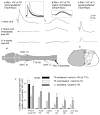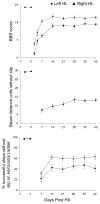Chronic spinal hemisection in rats induces a progressive decline in transmission in uninjured fibers to motoneurons
- PMID: 19320005
- PMCID: PMC2889190
- DOI: 10.1016/j.expneurol.2009.01.004
Chronic spinal hemisection in rats induces a progressive decline in transmission in uninjured fibers to motoneurons
Abstract
Although most spinal cord injuries are anatomically incomplete, only limited functional recovery has been observed in people and rats with partial lesions. To address why surviving fibers cannot mediate more complete recovery, we evaluated the physiological and anatomical status of spared fibers after unilateral hemisection (HX) of thoracic spinal cord in adult rats. We made intracellular and extracellular recordings at L5 (below HX) in response to electrical stimulation of contralateral white matter above (T6) and below (L1) HX. Responses from T6 displayed reduced amplitude, increased latency and elevated stimulus threshold in the fibers across from HX, beginning 1-2 weeks after HX. Ultrastructural analysis revealed demyelination of intact axons contralateral to the HX, with a time course similar to the conduction changes. Behavioral studies indicated partial recovery which arrested when conduction deficits began. In conclusion, this study is the first demonstration of the delayed decline of transmission through surviving axons to individual lumbar motoneurons during chronic stage of incomplete spinal cord injury in adult rats. These findings suggest a chronic pathological state in intact fibers and necessity for prompt treatment to minimize it.
Figures





References
-
- Antonino-Green DM, Cheng J, Magnuson DS. Neurons labeled from locomotor-related ventrolateral funiculus stimulus sites in the neonatal rat spinal cord. J Comp Neurol. 2002;442:226–38. - PubMed
-
- Arvanian VL, Bowers WJ, Anderson A, Horner PJ, Federoff HJ, Mendell LM. Combined delivery of neurotrophin-3 and NMDA receptors 2D subunit strengthens synaptic transmission in contused and staggered double hemisected spinal cord of neonatal rat. Exp Neurol. 2006;197:347–52. - PubMed
-
- Arvanian VL, Schnell L, Horner PJ, Bowers WJ, Federoff HJ, Schwab ME, Mendell LM. Combination Treatment With NT-3, NMDA-2d Subunits, And Anti-Nogo-A Antibody Increases Connections Of Transected Lateral Funiculus. Fibers To Lumbar Motoneurons Society For Neuroscience Abstracts #555.2 2006
-
- Ballermann M, Fouad K. Spontaneous locomotor recovery in spinal cord injured rats is accompanied by anatomical plasticity of reticulospinal fibers. Eur J Neurosci. 2006;23:1988–96. - PubMed
-
- Bareyre FM, Kerschensteiner M, Raineteau O, Mettenleiter TC, Weinmann O, Schwab ME. The injured spinal cord spontaneously forms a new intraspinal circuit in adult rats. Nat Neurosci. 2004;7:269–77. - PubMed
Publication types
MeSH terms
Grants and funding
LinkOut - more resources
Full Text Sources
Other Literature Sources
Medical

